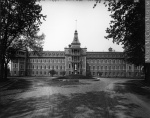Difference between revisions of "Portal:Featured Article Of The Week"
M-Explorer (talk | contribs) |
M-Explorer (talk | contribs) |
||
| Line 1: | Line 1: | ||
{{FAformat | {{FAformat | ||
| − | |Title= | + | |Title= Longue Pointe Asylum |
| − | |Image= | + | |Image= V11268.jpg |
|Width= 150px | |Width= 150px | ||
| − | |Body= | + | |Body= Founded in 1873, Saint-Jean de Dieu Hospital was born from an agreement between the Government of Quebec and the Congregation of the Sisters of Providence, who were entrusted the task of clothing, lodging and caring of the mentally handicapped. Sister Thérèse de Jésus was the soul and director of this important healthcare facility in Quebec. |
| − | The | + | The Sisters of Providence already had a great deal of experience in working with mental patients. Mother Émilie-Gamelin took in a number of them at the Asile de la Providence, as early as 1845. In 1852, their Saint-Isidore farm was renovated to accommodate 17 patients. In 1863, an annex named Saint-Jean de Dieu was built and added to the Sister’s convent in the east end of Montreal. |
| + | |||
| + | The construction of the Saint-Jean de Dieu Hospital, then known as the Longue Pointe Lunatic Asylum, would be done on this very site. In April 1874, the Sisters commissioned architect Benjamin Lamontagne to design and build the asylum, north of Notre-Dame St. It is interesting to know that Louis Riel was committed to the Asylum at Longue Pointe for a few months in 1876. | ||
| + | |||
| + | In 1890 a fire that killed more than 80 people reduced a large part of the hospital to an empty shell. Wooden pavilions were quickly erected to accommodate the 1,200 patients. In 1888, more land was added which brought the property of the Sisters of Providence to a total of 800 acres. In 1896, flooding of the asylum caused a temporary relocation of the facility. [[Longue Pointe Asylum|Click here for more...]] | ||
}} | }} | ||
Revision as of 04:49, 8 December 2014
Featured Article Of The Week
Longue Pointe Asylum
Founded in 1873, Saint-Jean de Dieu Hospital was born from an agreement between the Government of Quebec and the Congregation of the Sisters of Providence, who were entrusted the task of clothing, lodging and caring of the mentally handicapped. Sister Thérèse de Jésus was the soul and director of this important healthcare facility in Quebec.
The Sisters of Providence already had a great deal of experience in working with mental patients. Mother Émilie-Gamelin took in a number of them at the Asile de la Providence, as early as 1845. In 1852, their Saint-Isidore farm was renovated to accommodate 17 patients. In 1863, an annex named Saint-Jean de Dieu was built and added to the Sister’s convent in the east end of Montreal.
The construction of the Saint-Jean de Dieu Hospital, then known as the Longue Pointe Lunatic Asylum, would be done on this very site. In April 1874, the Sisters commissioned architect Benjamin Lamontagne to design and build the asylum, north of Notre-Dame St. It is interesting to know that Louis Riel was committed to the Asylum at Longue Pointe for a few months in 1876.
In 1890 a fire that killed more than 80 people reduced a large part of the hospital to an empty shell. Wooden pavilions were quickly erected to accommodate the 1,200 patients. In 1888, more land was added which brought the property of the Sisters of Providence to a total of 800 acres. In 1896, flooding of the asylum caused a temporary relocation of the facility. Click here for more...
